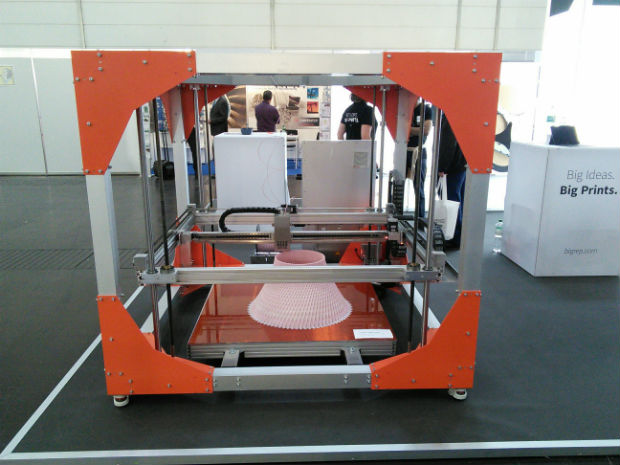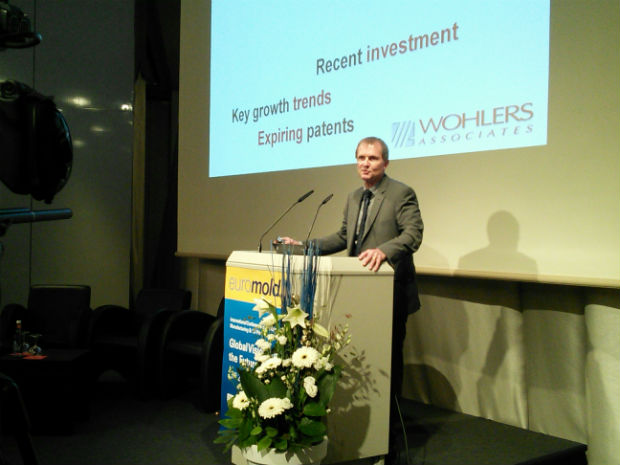Casting a Positive Global View on 3D Printing

Latest News
September 24, 2015
By Randall Newton
There is a lot of talk in manufacturing circles that 3D printing (3DP) is overhyped and underwhelming. Stock prices for the public companies in the space are plummeting, and the new wave of budget-class 3D printers looks more like a ripple, according to these naysayers. So the speakers this week at the 17th annual International Wohlers Conference (which has become a fixture at Germany’s Euromold trade fair) took on all that negativity head-on.
For the past few decades, Germany’s Euromold has reigned as the world’s largest trade show dedicated to the manufacturing processes of mold and pattern making, tooling, design, additive manufacturing (3D printing), and product development. For the last 17 years, Euromold has partnered with Wohlers Associates for an opening-day conference; “Wohlers” being renown 3D printing business consultant Terry Wohlers of Colorado.
When IT business analyst firm Gartner took a look at 3D printing earlier this year, using its famed Hype Cycle, it stated that “3D Printing in Manufacturing Operations” and “Consumer 3D Printing” have left the “Peak of Inflated Expectations” and entered the “Trough of Disillusionment.” Keynote speaker Autodesk CTO Jeff Kowalski pointed out the Gartner view as the natural path for an “overnight success 35 years in the making.”
Predicting Changes in Technology
To move the industry along, Kowalski says the biggest changes required will not come from the printers themselves, but from the software used to design products and provide the data to the printers. “CAD is still Computer Aided Documentation ... CAM is still Computer Automated Milling.” The tools need to become capable of “infinite expressibility” so those who use their imagination to innovate can design without the limitations of today. Kowalski described new developments in generative design, machine learning and multi-dimensional physical analysis, which along with advances in 3D printing materials and continued improvement in the printers will give the manufacturing industry “experienced systems.” Kowalski’s vision of the future of 3D printing is one where “we move from best efforts to best outcomes.”
 In addition to printing capabilities, speakers at Euromold say that software and design mindset are part of innovation as well.
In addition to printing capabilities, speakers at Euromold say that software and design mindset are part of innovation as well.Materialise CEO Wilfried Vancraen took exception to some of Kowalski’s vision. “Design tools are not the bottleneck; mindsets are.” Some of the industry’s best successes are found in medical applications, Vancraen said. Dental implants and braces and hearing aid design are skyrocketing in use because of two factors:
- The size of the items means they print reasonably fast;
- They both start from scan data, creating a fully digital workflow.
One area starting to make a big impact is the design of internal lattice structures in 3D printing with metal. “Lattice structures blur the boundaries between materials and shapes,” says Emmett Lalish, a senior mechanical engineer at Microsoft. “It opens up new possibilities at every scale.” Lalish described lattice structures that can allow a metal to contract instead of expand with heat, or become stronger with applied pressure.
 Lattice structures are being utilized more in 3D printing to develop lightweight, stronger structures.
Lattice structures are being utilized more in 3D printing to develop lightweight, stronger structures.Looking at China
Perhaps no one in the room was more optimistic about the future of 3D printing than Gordon Styles, who left the U.K. 10 years ago to start a prototyping business in China. From an initial investment of $5,000 in 2005 Star Prototype has become a 200-employee business generating €13 million ($14.5 million) in revenue. Styles says the Chinese government has set its sights on making China the world’s largest user of 3D printing. It has committed $1 billion for research and development, seeding 3D printers into businesses and schools, from elementary to university. “They want to utterly dominate [the industry], and I think in 25 years they will,” said Styles. Kids in his neighborhood now play with toys they 3D printed at school.
Because of the end-of-life for key early patents in 3D printing, Styles foresees a continued drastic drop in the price of entry-level 3D printing. China will take advantage of that price drop, and also encourage the local development of inexpensive 3D printing. “Don’t believe [the business press]; China is here to stay.”
Follow Desktop Engineering for more Euromold coverage after the show concludes.
Subscribe to our FREE magazine, FREE email newsletters or both!
Latest News







